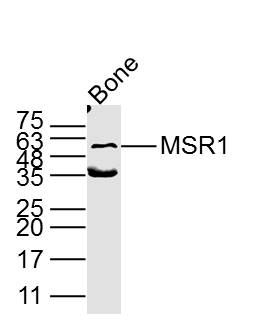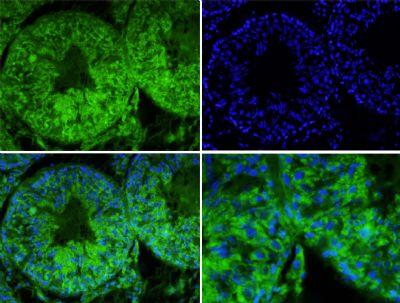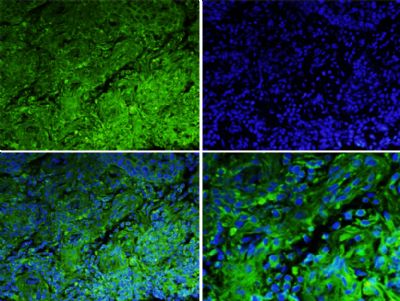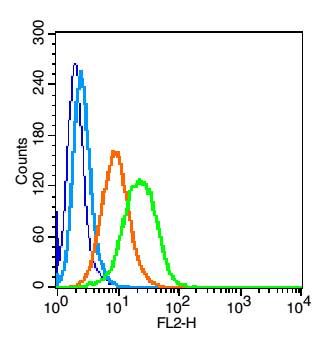Sample:
Lane 1: Spleen (Mouse) Lysate at 40 ug
Lane 2: Lung (Mouse) Lysate at 40 ug
Lane 3: Liver (Mouse) Lysate at 40 ug
Lane 4: Placenta (Mouse) Lysate at 40 ug
Lane 5: Cerebrum (Mouse) Lysate at 40 ug
Lane 6: Raw264.7 (Mouse) Cell Lysate at 30 ug
Lane 7: NIH/3T3 (Mouse) Cell Lysate at 30 ug
Lane 8: Liver (Rat) Lysate at 40 ug
Lane 9: Cerebrum (Rat) Lysate at 40 ug
Primary: Anti-MSR1 (SL6763R) at 1/1000 dilution
Secondary: IRDye800CW Goat Anti-Rabbit IgG at 1/20000 dilution
Predicted band size: 50/39 kD
Observed band size: 50 kD
Sample: Hela Cell (Human) Lysate at 40 ug
Primary: Anti-MSR1 (SL6763R) at 1/300 dilution
Secondary: IRDye800CW Goat Anti-Rabbit IgG at 1/20000 dilution
Predicted band size: 50 kD
Observed band size: 50 kD
Sample: Bone (Mouse) Lysate at 40 ug
Primary: Anti-MSR1 (SL6763R) at 1/300 dilution
Secondary: IRDye800CW Goat Anti-Rabbit IgG at 1/20000 dilution
Predicted band size: 50 kD
Observed band size: 50 kD
Tissue/cell: mouse testis tissue;4% Paraformaldehyde-fixed and paraffin-embedded;
Antigen retrieval: citrate buffer ( 0.01M, pH 6.0 ), Boiling bathing for 15min; Blocking buffer (normal goat serum,SLC0005) at 37℃ for 20 min;
Incubation: Anti-MSR1 Polyclonal Antibody, FITC conjugated(SL6763R-FITC) 1:100, 60 minutes at 37°C. DAPI(5ug/ml,blue,SLC0033) was used to stain the cell nuclei
Tissue/cell: human colon carcinoma;4% Paraformaldehyde-fixed and paraffin-embedded;
Antigen retrieval: citrate buffer ( 0.01M, pH 6.0 ), Boiling bathing for 15min; Blocking buffer (normal goat serum,SLC0005) at 37℃ for 20 min;
Incubation: Anti-MSR1 Polyclonal Antibody, FITC conjugated(SL6763R-FITC) 1:100, 60 minutes at 37°C. DAPI(5ug/ml,blue,SLC0033) was used to stain the cell nuclei
Blank control(Blue): U937(fixed with 2% paraformaldehyde (10 min)).
Primary Antibody:Rabbit Anti-MSR1 antibody(SL6763R), Dilution: 1μg in 100 μL 1X PBS containing 0.5% BSA;
Isotype Control Antibody: Rabbit IgG(orange) ,used under the same conditions );
Secondary Antibody: Goat anti-rabbit IgG-PE(white blue), Dilution: 1:200 in 1 X PBS containing 0.5% BSA.
|





